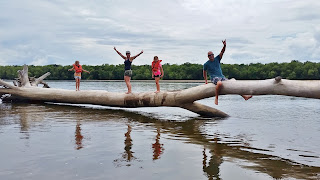A couple of
days ago I and a fellow worker decided to hike into Baxter's Hollow.
It had rained in the morning but the sky was supposed to clear up in
the afternoon. The skies hadn't cleared but we took a chance. As we
headed out of the parking lot there were a few drops of rain. The
majority of the drops were caught by the tree canopy and if we got
wet, “Oh
well.”
Nature hiking was something new for my
young companion;
he thought we were going for a walk. Baxter's Hollow is a bit more
like a walk as it's a black-topped road,
although you seldom see cars beyond the
parking lot. Again,
being that it was late in the day,
there was very little wildlife activity. The sounds
of the creek flowing a bit faster from all of the recent rainfall and
the chirping of chick-a-dee provided
a pleasant
back drop to our conversation.
I don't know that he was particularly interested,
but I stopped to point out
the late season wildflowers. Near the stream
I spotted the pure white tube-like
flowers of a turtlehead,
a first for me. Along the road the pale smooth
blue aster blended with several white
types. Here and there were the red
grape-like seed
bunches of false Solomon’s seal.
Soon we spotted someone off in the distance so we held our chatter
down to a low tone. During a short visit with the gentlemen we
discovered the bird watcher had been in the Sauk Prairie area for a
few days,
although the license plate on his car indicated he had driven from
Illinois. He told us that he actually lived in Washington DC. He said
he wasn't having much luck birding but
was enjoying the walk.
Soon we could hear
the rushing of the water as it passed
under the next bridge. Mother
Nature knew that today I had my camera
and she offered another chance to get a
great photo of the cardinal flower (much
closer than I would have had on the boat outing). Not only is the
color of the bloom as red
as the male cardinal
but if you look close at the blooms you can see the shape of an
origami bird. Its
wings spread wide on each side with
its head
held high.
Soon we came to
the gravel part of the road that leads to what years ago was called
the Klondike Campground. This area is a bit more swampy;
here we were greeted by the delicate orange,
slipper-like flowers
of orange jewelweed, accented
by the pinkish-purple of
ironweed.
As we neared the end of the hike a pickup truck passed us and parked
in the last parking area. As we approached,
a couple came back down a short footpath. We struck
up a conversation
with them;
like the earlier guy they were from Illinois but they were on a day
trip. They
had recently looked at old photos and came to see what was left of
the campground that they and their children had enjoyed forty years
ago. They were disappointed that the campground was gone but
were pleased with what they found. As a
child I had been here as a drive-through
only visitor so their memories were very
interesting. This prompted us
to walk the footpath as they had.
The entire area of the old campground was covered in the bright
yellow spires of many
types of goldenrod, including zig-zag,
gray and giant goldenrod. Along the
wetland edges, massive patches
of Joe Pye weed created a backdrop of purple.
When we got back
to the car we had spent two and a
half hours in nature and never once did my young companion lose
interest or get out his cell phone. He agreed to go to Ferry Bluff so
I may have awoken
the naturalist in him.






